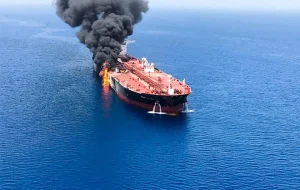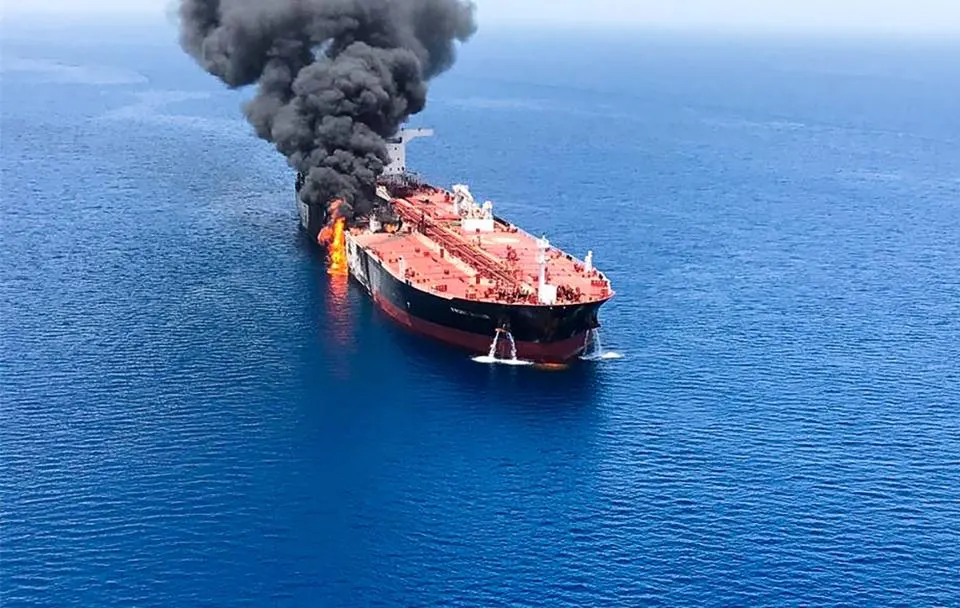How do maritime security threats affect shipping in the Persian Gulf? Explore the real-world impacts of piracy, state conflicts, and cyber risks in this data-driven and accessible guide for maritime professionals and students.

The Persian Gulf is not just a busy sea lane—it’s a lifeline for the global economy. Stretching between some of the world’s most strategically sensitive and resource-rich countries, this narrow body of water sees the movement of over 21 million barrels of oil per day (U.S. EIA, 2024). But its importance also makes it vulnerable. Tanker seizures, drone attacks, geopolitical tensions, and emerging cyber threats have created a volatile landscape for maritime operators.
Understanding how maritime security threats impact Persian Gulf shipping is not just important for policymakers or military strategists. It’s essential for shipowners, port authorities, crewing agencies, insurers, and maritime students looking to grasp the complexity of one of the most watched maritime zones in the world.
Why Maritime Security in the Persian Gulf Matters to Global Shipping
The Persian Gulf connects oil-rich nations—Saudi Arabia, Kuwait, Iran, Iraq, Qatar, and the UAE—to world markets through the Strait of Hormuz, a narrow chokepoint with a width of just 21 miles. According to UNCTAD (2024), more than 30% of global seaborne-traded crude oil originates from Persian Gulf ports.
Disruption here affects everything—from the price of fuel at the pump in Europe to energy access in Asia. Moreover, the Gulf is not only about oil. It’s a route for LNG carriers, container ships, and supply vessels serving the region’s mega ports like Jebel Ali (UAE), Ras Laffan (Qatar), and Bandar Abbas (Iran).
This mix of high-value cargo, geopolitical tension, and narrow sea lanes makes the region uniquely exposed to threats.
–
The Main Types of Maritime Security Threats in the Persian Gulf
State-Based Military Incidents
The Persian Gulf is bordered by countries with competing territorial claims and longstanding rivalries. Incidents such as the 2019 seizure of the British-flagged Stena Impero by Iran and retaliatory sanctions illustrate how quickly commercial shipping can become entangled in state conflict.
During such periods, shipping lanes become militarized. Naval vessels from the U.S., UK, France, and regional navies establish escort systems or patrol areas near the Strait of Hormuz. Insurers categorize the region as “high-risk,” increasing war risk premiums by up to 10x during crisis periods (Lloyd’s List Intelligence, 2023).
Drone and Missile Attacks
In recent years, attacks on ships using unmanned aerial vehicles (UAVs) and explosive-laden boats have emerged as a new threat class. In 2021, the MT Mercer Street, a Liberian-flagged oil tanker managed by an Israeli firm, was struck by a drone off the Omani coast, killing two crew members.
These asymmetric threats are difficult to detect and attribute, yet they disrupt shipping schedules and fuel geopolitical escalation.
Cybersecurity Threats to Ship Operations
The digital transformation of shipping, while improving efficiency, also introduces vulnerabilities. Shipboard IT systems, including navigation (ECDIS), engine controls, and cargo management platforms, can be hacked to disable or reroute a vessel.
According to DNV’s Maritime Cyber Priority Report (2023), 36% of maritime companies in the Gulf experienced at least one cyber incident in the last three years. Common vectors include:
- Spoofing of AIS positions
- Ransomware attacks on port terminals
- Data breaches from weak onboard firewalls
Piracy and Armed Robbery
While piracy is more concentrated in the Gulf of Aden and Strait of Malacca, armed robbery and opportunistic boarding have occurred in the northern Gulf, particularly during periods of regional instability.
The International Maritime Bureau (IMB) classifies certain areas near Iraqi and Iranian ports as elevated-risk zones.
Human Factors and Insider Threats
The Persian Gulf’s complex legal, cultural, and political environment makes crew management and vessel compliance a significant challenge. Untrained or poorly vetted crew can fall victim to coercion or unintentionally violate regional regulations, exposing the vessel to detention or fines.
Shipowners and P&I clubs have urged stronger vetting of crew operating in the Gulf and enhanced Maritime Labour Convention (MLC 2006) compliance.
–
Real-World Case Studies of Disruption
Case Study: 2019 Strait of Hormuz Tanker Crisis
Between May and August 2019, six oil tankers were attacked near the Strait of Hormuz. The attacks—using mines and suspected limpet charges—caused explosions and fires on board. The IMO called for global restraint, while Operation Sentinel, a U.S.-led coalition, began providing naval escorts.
Impact:
- Insurance premiums for tankers rose by 400%.
- Several operators, including Maersk Tankers, re-routed ships via Fujairah to avoid Hormuz.
- Port calls at Iranian terminals dropped significantly as owners feared secondary sanctions.
Case Study: Jebel Ali Cyber Attack Attempt
In 2022, the Port of Jebel Ali—one of the busiest transshipment hubs—thwarted a ransomware attack aimed at its terminal operating system. Thanks to in-network firewalls and AI anomaly detection, the malware was isolated before it could halt container operations.
This reinforced the need for IMO Resolution MSC.428(98), which mandates cyber risk management in safety management systems by 2021.
–
Current Mitigation Measures and Security Frameworks
Naval Coalitions and Escorts
- CMF (Combined Maritime Forces) and IMX (International Maritime Exercise) regularly coordinate patrols.
- The UK Maritime Trade Operations (UKMTO) provides real-time security updates to commercial ships.
Maritime Domain Awareness (MDA) Tools
- AIS and LRIT data are integrated into Inmarsat, MarineTraffic, and SeaVision platforms.
- The EU NAVFOR uses satellite imagery to detect suspicious movements.
Port State Control and ISPS Compliance
All Persian Gulf ports operate under International Ship and Port Facility Security Code (ISPS) protocols. Ships calling in must submit advance security notifications, crew lists, and cargo manifests. Inspections are routinely carried out by Paris MoU and Indian Ocean MoU authorities.
Cybersecurity Best Practices
- Ships use two-factor authentication for critical IT systems.
- Vendors like Wärtsilä and Kongsberg offer shipboard cyber protection suites.
- IMO recommends adoption of Guidelines on Maritime Cyber Risk Management (MSC-FAL.1/Circ.3).
–
Future Outlook: Navigating Security in the Decade Ahead
As the world’s energy demands evolve, so too will the threat landscape in the Persian Gulf. Here are some key projections:
- Increased Use of AI for Threat Detection: Ports in Abu Dhabi and Ras Laffan are investing in AI-based perimeter monitoring and smart surveillance.
- Green Corridors Will Require New Security Norms: With hydrogen and ammonia shipments expected to rise, vessels may face new sabotage risks.
- Autonomous Vessels May Become Targets: As Gulf states trial autonomous shipping (UAE and Saudi pilot projects), regulatory frameworks for their protection must evolve.
- Greater Regional Cooperation: Gulf Cooperation Council (GCC) countries are formalizing joint maritime security protocols, which could reduce duplication and improve readiness.
According to the World Economic Forum’s Global Risk Report (2024), maritime infrastructure sabotage ranks among the top 10 projected global threats.
–
FAQ
Why is the Persian Gulf considered a high-risk shipping area?
Due to its narrow geography, political tensions, and high concentration of oil and gas exports, the Gulf is prone to military standoffs, drone attacks, and cyber threats.
How do shipowners protect their vessels in the region?
Many use private maritime security firms, subscribe to UKMTO alerts, and equip vessels with hardening measures like razor wire and long-range acoustic devices.
What role does the IMO play in Persian Gulf security?
The IMO sets global standards for safety, including ISPS compliance, cybersecurity guidance, and navigational routing regulations for chokepoints like Hormuz.
Can ships avoid the Persian Gulf altogether?
Some pipelines like the East-West Petroline (Saudi Arabia) and ports like Fujairah help bypass Hormuz, but most oil and gas must still transit the Gulf.
Is piracy still a concern in the region?
Piracy is limited but armed robbery and suspicious boarding occur in localized areas. Intelligence-sharing and onboard vigilance remain key.
–
Conclusion
Maritime security threats in the Persian Gulf are complex, evolving, and deeply interwoven with regional and global politics. From drone strikes to ransomware, the risks extend beyond the visible horizon of naval patrols. Yet the industry is responding—through better coordination, smarter tech, stronger training, and enhanced resilience planning.
Whether you are navigating VLCCs through Hormuz or managing port infrastructure in Dubai, staying alert to these threats is not optional—it’s operationally vital. The waters may not calm soon, but with the right tools and partnerships, maritime stakeholders can steer through them with foresight and confidence.
References
- U.S. Energy Information Administration (2024). “Strait of Hormuz Fact Sheet.” EIA.gov
- UNCTAD (2024). “Review of Maritime Transport.” unctad.org
- DNV (2023). “Maritime Cyber Priority Report.” dnv.com
- Lloyd’s List Intelligence (2023). “Maritime Risk Ratings.” lloydslist.maritimeintelligence.informa.com
- IMO (2021). “Cyber Risk Management Guidelines.” imo.org
- BIMCO (2023). “Maritime Security Advisories.” bimco.org
- The Nautical Institute (2024). “Security Briefings for Gulf Operations.” nautinst.org
- MarineTraffic (2024). “Vessel Tracking and Security Zones.” marinetraffic.com
- Wärtsilä (2023). “Cyber Solutions for Smart Vessels.” wartsila.com
- International Maritime Bureau (2023). “Piracy Reports.” icc-ccs.org

